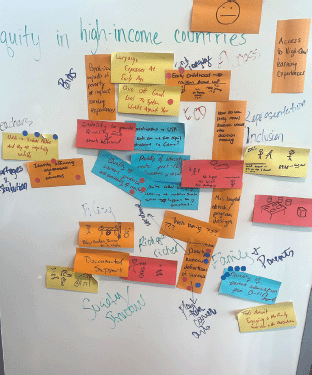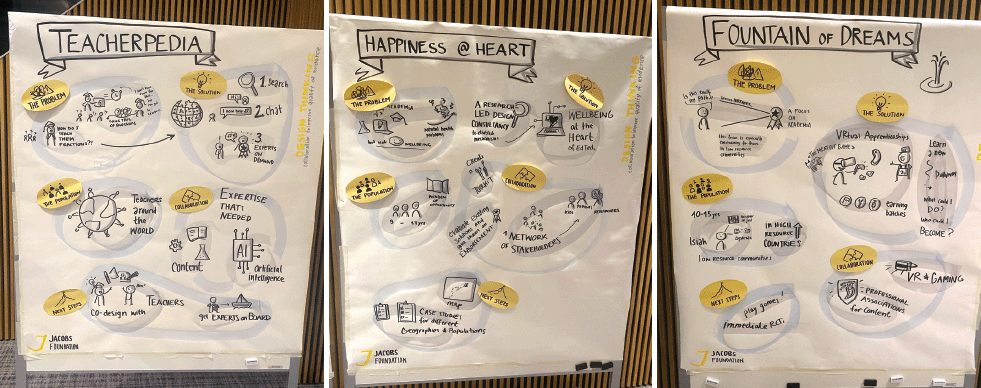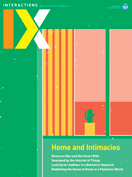Authors:
Gillian R. Hayes, Candice Odgers, Julie A. Kientz, Jason C. Yip, Kiley Sobel, Morgan Ames, Anamara Ritt-Olson
Launching a global network to enhance impact and collaboration among researchers, innovative companies, venture capitalists, and foundations is a daunting task. We sought to do just that in the area of technology, learning, and child development this year. Translating founder to foundation, researcher to practice, and maker to investor is hard enough, but then you have to convince them to work together. At a recent three-day workshop in Germany, the Jacobs Foundation brought together some of the world's best researchers, heads of some of the most innovative edtech companies, and decision makers from those investing in this space either through charitable giving or impact investing. The capstone event was a marathon afternoon codesign session led by our team. What resulted was the design of a new global network and the seeds of many projects, some technologically oriented and some more focused on policy and practice. In this article, we describe the process, outcomes, and what we recommend to others looking to use codesign as a method for team science or research-to-practice (and practice-to-research) translation.
Our five-hour codesign workshop engaged participants and promoted collaboration across locations, disciplines, and roles in the child development, learning, and technology ecosystem. We presented three primary goals to participants:
- Establish concrete new collaborations
- Identify problem areas and ideas that groups are excited to work on
- Build teams by showcasing the assets each participant brings to design
Participants were informed early that the output of the afternoon would be a five-slide "pitch deck" from each team describing the problem, population, potential solution or approach, proposed collaboration, and next steps and future directions.
We benefited from having spent a few days together talking about some of the major issues confronting the field. During that time, people had been placing Post-it notes on boards as interesting challenges and opportunities emerged in their discussions. Our team then grouped the sticky notes during a series of breaks, creating generalized themes using affinity diagramming. These notes and associated themes were prominently displayed in a break area, and participants were encouraged to add more, move them around, and group them. By the time the codesign sessions began, we already had a list of seven topics for teams to take on, as well as a list of10 cross-cutting themes to be considered by every team (Figure 1). We placed rolling whiteboards with the topics around the room so that they were clearly visible as people entered. However, we asked participants not to break into groups yet.
 | Figure 1. Topics and themes that emerged during initial discussions. |
Sitting at small tables in the center of the room, away from the topical boards, participants first listened to a short introduction to our goals for the afternoon and a lecture on design thinking that noted the codesign efforts would focus on the understand, observe, define, and ideate portions of this structure (Figure 2).
 | Figure 2. The assembled team listening to an introductory lecture by Jason Yip and Julie Kientz on design thinking. |
They then formed groups of six to eight, according to the topics around the room, with the requirement that at least one researcher and one person from industry were in every group. Because they were unable to attend the entire session, foundation and VC representatives were free to assemble as they wanted, though they were encouraged to spread out. In the end, every group had at least one member of each of the four subgroups. Each subgroup had a colored sticker on their name tag denoting which group they were in; they had been tagged this way all week. Even before the design session, it had become common parlance among the groups to say "Blue dots over here" when a session for researchers was starting. The visual reminder and quick reference helped everyone remember to include differing backgrounds and perspectives and made it easy for facilitators to call on people when they noticed a subgroup being quiet during parts of the conversation. Three facilitators joined teams in need of researchers, two remained the primary facilitators, and the rest acted as floaters, moving among the teams as they progressed through the remaining activities.
The steps of codesign. Understand and observe: Individuals had 15 minutes to doodle and note potential challenges for specific research problems.
Define the problem: Part 1. In the next 15 minutes, teams translated their doodles to sticky notes and shared them within their groups to narrow down the challenges (Figure 3).
 | Figure 3. Sticky notes showing the various scenarios developed in the ideation stage. Dot stickers signify votes; handwritten comments and arrows on the whiteboard show connections. |
At this point, the teams had a group coffee break to mull over their ideas and chat across groups. Half of the participants—the VCs and funders—then departed for another meeting.
Define the problem: Part 2. Following the coffee break, the teams participated in their first design game, "Big Picture of the Project," in which they used Story Cubes, a set of dice with random icons (https://www.storycubes.com/en/), to tell a story about their problem, challenge, and project area. This game was the first time in the session that participants began to question the process, which is a common concern when people who have not yet built creative confidence are asked to be creative [1]. We encouraged them to trust the process, and although it felt silly at first, the teams used the Story Cubes to stretch their thinking, with one team even incorporating a picture of a fountain that came up on a dice roll into the title of their final idea.
Over the next 30 minutes, teams built on the creativity they had developed during the first design game with a second design game, this one focused on sketching. On paper and whiteboard only—no digital devices were allowed—teams drew solutions to the problems they had described in their initial brainstorming session and during their story development. Teams were encouraged to modify, magnify, minimize, substitute, rearrange, and combine one another's solutions based on Osborn's Checklist [2].
Narrow down scope. Once ideas had been generated, teams used another 30 minutes to vote on ideas and solutions they wanted to pursue (Figure 2). At this point, the teams were encouraged to think about not only what was exciting but also what was doable, something they had been explicitly encouraged to avoid up to this point.
Compile pitch deck. In the final hour of independent work, teams made their five-slide pitch deck. They were provided a template in Google Slides but encouraged to change and expand on that template to match their needs.
Pitches. In the final hour of the session, the VCs and foundation staff returned from their meeting and rejoined their teams, with each team presenting for five minutes.
During this time, the audience participated in the final design game, using sticky notes in three colors that we had distributed around the room during the break:
- Roses (red): What do you love about this idea?
- Buds (orange): What new ideas do you have?
- Thorns (blue): What might be challenging about this idea?
All projects were pitched collaboratively to an audience of the foundation event organizers, the VC and nonprofit funders, and the researchers and entrepreneurs who had completed the design sessions in their teams. The presented projects represented diversity in approach, both technological and educational, as well as in their topic areas. Concepts ranged from systems to share educational materials and ideas for educators, to internships based in virtual reality, to mental health support for diverse learners, particularly those in conflict zones. Each of these projects developed further in some way following the event. In some cases, the follow-ons were remote video sessions about a variety of topics, while others were nascent collaborations and grant proposals. All pitches were captured by a sketch artist (Figure 4).
As just one spotlight from among these projects, a collaboration emerged inspired by the conference keynote presentation by Ramin Shahzamani, CEO of War Child Holland (https://www.warchildholland.org/), and a subsequent design session around promoting resilience in conflict zones. Part of a rapid pilot grant mechanism, this project focuses on providing adolescents living in high-conflict regions, particularly Ukraine, with the supports and skills required to reduce bedtime rumination and improve sleep duration and quality. It was recently funded by the John Templeton Foundation (https://www.templeton.org/). The project leverages technology-supported interventions to target two interacting and important risk processes for developing anxiety, depression, and PTSD: 1) excessive worry/rumination and 2) sleep difficulties. The project was conceived of, developed, and funded in just a few months starting with these codesign workshops. Even more compelling, the particular interdisciplinary and collaborative approach deployed—made possible through codesign—is well suited to scale to reach a large population of youth at high risk for bedtime rumination and for whom sleep deficits pose immediate and long-term threats to their health, the kind of impact that collaborative and community-based design approaches best enables.
Codesign can be deployed in a wide variety of ways. In this work, we used the concept and pragmatics of designing for a specific educational technology tool to better define our loose organization and further develop our networks. Some key lessons emerged from this approach.
This design session came at the end of an intense three-day workshop. Participants, most of whom were strangers three days earlier, had been a part of multiple shared discussions. In this way, the codesign sessions began more heavily grounded than some community-based and/or interdisciplinary design sessions might. By developing a set of topics from among those that had been discussed and describing them as the core of the team projects, the facilitators set the stage for some shared background. These topics, albeit loosely defined, appeared to be essential for establishing trust among participants. In particular, those who had never designed before were visibly uncomfortable at the beginning and during some of the more creativity- and innovation-focused activities. These same team members began to speak up more and relaxed their shoulders and leaned in when subject matter expertise was required, or when more practical aspects of the projects were being worked through. In community-based research and codesign projects, often there are team members with limited design experience. Our experiences reminded us that highlighting the non-design expertise of design teams is essential to success.
This design session, although tackling five different projects, took place in one large room. Each team had an area that they could call their own, but there were no barriers—visual or auditory—between the teams. This visibility and shared space created an audible buzz of discussion and excitement, with people standing up to move around whiteboards, get closer to one another, and sometimes to check on the other teams. In some cases, however, team members appeared to disengage, paying attention to what other teams were doing rather than focusing on their own work, or to compete, attending to their own team's work through the lens of what other teams were doing. Nearly every participant was of high status within their own organizations: full professors at major universities, officers at well-known foundations, C-level representatives and founders of companies, established venture capitalists, and so on. Thus, some attempts to understand or even impress the other attendees might be expected. We observed limited competitive behavior, however, and found individuals and teams to work closely together, with intense engagement. The high status may also have reduced risk for some participants as well as made them more likely to speak up and engage with others. Similar efforts with more-junior members of the research network will provide additional insight into how status and experience may influence behaviors in these spaces.
Finally, the timing of the effort is something to explore further for others seeking to replicate these results. Had the workshop happened earlier in the meeting, there would have been more time to build on the ideas, and perhaps more firmly establish the emergent collaborations while colocated. However, it might also have been a less engaged and less comfortable group, not having the ideas, or the relationships, that had been developed over the preceding days.
As any good human resources professional or leadership coach will tell you, new projects, joint efforts, and collaborative engagements are all experiences that can be designed. So why not use one of the core tools in the user experience design toolbox to do so? Indeed, in many ways what HCI researchers and practitioners know as codesign today stems from the early days of workplace design and the Scandinavian tradition of participatory design [3]. What we saw in this workshop that is so important was a shift in attitude, engagement, and enthusiasm when people were forced to work together hands-on. Yes, this hand-selected group of people had already spent three days together in a beautiful location and were mostly getting along. However, things tended, as they do in such meetings, to stay closer to the surface than true collaborative engagement requires. Over time, tighter relationships might have built more organically, particularly for those new colleagues who live and work somewhat near one another. When you are attempting to rapidly scale a truly global network of people who do not work in the same field, vary in their interaction norms, and have wildly different incentives for their work, however, a more aggressive intervention is necessary. For us, codesign was the aggressive intervention to jump-start the effort.
The shared experience of the workshop helped establish deeper connections and partnerships. Codesign requires active participation and learning that enabled many workshop attendees to synthesize what they had heard and learned throughout the week into their thinking in a rapid way. They described thinking about how to apply what they had learned in the designing of a new project as helpful in reflecting on what they learned and what they wanted to bring back to their organizations. This kind of sharing outside the workshop had not been an explicit goal but again speaks to the impact that these active collaborative design activities can have. Perhaps most importantly, we found that the codesign work did launch the collaborative efforts we had hoped would result. In many ways, being out of their comfort zone likely helped everyone develop trust in one another and establish a shared vocabulary—not only of words related to design that had been new to many but also the kinds of inside jokes that come from intense collaboration and impromptu presentations. Finally, this codesign activity gave participants a glimpse into team dynamics and relational communication abilities. Participants who followed up with others did so in part because they already knew how it might be to work with a new partner and were more willing to take a risk and get started on a project.
Scholars have examined how we can do "team science" for years (e.g., the Science of Team Science work from the National Academies of Sciences, Engineering, and Medicine; https://www.nationalacademies.org/our-work/the-science-of-team-science). Design, and in particular codesign, aligns well with many of the principles of team science. In our experience, codesign can jump-start novel scientific and research-practice collaborations. This type of rapid acceleration may be particularly important in a post-pandemic world in which we enhance remote collaborations and consider our scholarly and design work on a truly global scale.
1. Rauth, I., Köppen, E., Jobst, B., and Meinel, C. Design thinking: An educational model towards creative confidence. Proc. of the 1st International Conference on Design Creativity, 2010.
2. Osborn, A. Applied Imagination: Principles and Procedures of Creative Problem-Solving. Scribner, New York, 1957.
3. Bødker, S. and Pekkola, S. Introduction the debate section: A short review to the past and present of participatory design. Scandinavian Journal of Information Systems 22, 1 (2010), 4
Gillian R. Hayes is the Kleist Professor of Informatics, vice provost for graduate education, and dean of the Graduate Division at the University of California, Irvine. Her research interests are in human-computer interaction, ubiquitous computing, assistive and educational technologies, and health informatics. [email protected]
Candice Odgers is a professor in the Department of Psychological Science and associate dean for research in the School of Social Ecology at the University of California, Irvine. She is a quantitative and developmental psychologist with expertise in adolescent mental health, intensive longitudinal data analysis, and experience sampling methodologies. Her research focuses on how early, daily, and online experiences influence children's health and development. [email protected]
Julie A. Kientz is a professor in and chair of the Department of Human Centered Design and Engineering at the University of Washington. Her research focuses on understanding and reducing the user burdens of interactive technologies for health, education, and families through the design of future applications. [email protected]
Jason C. Yip is an associate professor of digital youth at the Information School and an adjunct assistant professor in the Department of Human Centered Design and Engineering at the University of Washington. He builds innovative technologies for new collaborations and examines how current technological trends already influence family collaborations around learning. [email protected]
Kiley Sobel is a senior user experience researcher at the language-learning edtech company Duolingo, where she does research with kids and parents on Duolingo ABC, the company's free English literacy learning app for kids. [email protected]
Morgan Ames is an assistant adjunct professor in the School of Information and interim associate director of research for the Center for Science, Technology, Medicine and Society at the University of California, Berkeley, where she teaches data science and administers the Designated Emphasis in Science and Technology Studies. [email protected]
Anamara Ritt-Olson is an associate professor in public health at the University of California, Irvine. Her research focuses on adolescent well-being. She creates, teaches, and evaluates health promoting programs to that end. [email protected]
Copyright held by authors
The Digital Library is published by the Association for Computing Machinery. Copyright © 2023 ACM, Inc.









Post Comment
No Comments Found